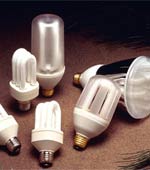compact fluorescent lamp

A compact fluorescent lamp (CFL) is a lamp that combine the energy efficiency of fluorescent
lighting with the convenience and popularity of incandescent fixtures.
CFLs can replace incandescents that are roughly 3–4 times their wattage,
saving up to 75% of the initial lighting energy. Although CFLs cost 10–20
times more than comparable incandescent bulbs, they last 10–15 times as
long.
 |
How CFLs work
CFLs work much like standard fluorescent lamps. They consist of two parts: a gas-filled tube, and a magnetic or electronic ballast. The gas in the tube glows with ultraviolet light when electricity from the ballast flows through it. This in turn excites a white phosphor coating on the inside of the tube, which emits visible light throughout the surface of the tube.
CFLs with magnetic ballasts flicker slightly when they start. They are also heavier than those with electronic ballasts. This may make them too heavy for some light fixtures. Electronic ballasts are more expensive, but light immediately (especially at low temperatures). They are also more efficient than magnetic ballasts. The tubes will last about 10,000 hours and the ballast about 50,000 hours. Most currently available CFLs have electronic ballasts.
CFLs are designed to operate within a specific temperature range. Temperatures below the range cause reduced output. Most are for indoor use, but there are models available for outdoor use. You can find a CFL's temperature range on most lamp packages. You should install outdoor CFLs in enclosed fixtures to minimize the adverse effects of colder temperatures.
CFLs are most cost effective and efficient in areas where lights are on for long periods of time. You'll experience a slower payback in areas where lights are turned on for short periods of time, such as in closets and pantries. Because CFLs do not need to be changed often, they are ideal for hard-to-reach areas.
Types of compact fluorescent lamps
CFLs are available in a variety of styles or shapes. Some have two, four, or six tubes. Others have circular or spiral-shaped tubes. The size or total surface area of the tube(s) determines how much light it produces.
Some CFLs have the tubes and ballast permanently connected. Other CFLs have separate tubes and ballasts. This allows you to change the tubes without changing the ballast. There are also types enclosed in a glass globe. These look somewhat similar to conventional incandescent light bulbs, except they're larger.
Sub-CFLs fit most fixtures designed for incandescent lamps. Although most CFLs fit into existing 3-way light sockets, only a few special CFL models can be dimmed.
Compared to incandescent lamps, compact fluorescent lamps, when used properly have the following advantages:
Table 1 compares the wattage of commonly available incandescent lamps and the wattage of a CFL that will provide similar light levels.
| Table 1. Comparable wattage of CFLs and incandescents | |
|---|---|
| Incandescent wattage | CFL wattage |
| 25 | 5 |
| 50 | 9 |
| 60 | 15 |
| 75 | 20 |
| 100 | 25 |
| 120 | 28 |
| 150 | 39 |
Table 2 shows how you can save money using CFLs. This table assumes the light is on for 6 hours per day and that the electric rate is 10 cents per kilowatt-hour.
| Table 2. Cost comparison: CFLs and iIncandescents | ||
|---|---|---|
| 27-watt compact fluorescent | 100-watt incandescent | |
| Cost of lamps | $14.00 | $0.50 |
| Lamp life | 1642.5 days (4.5 years) | 167 days |
| Annual energy cost | $5.91 | $21.90 |
| Lamps replaced in 4.5 years | 0 | 10 |
| Total cost | $40.60 | $103.55 |
| Savings over lamp life | $62.95 | 0 |
Incandescent lamps have a few advantages over CFLs. The color rendition index of incandescent lamps is superior to CFLs. Incandescents also project light further. This makes them more appropriate for some applications, such as for lighting in high ceilings.
